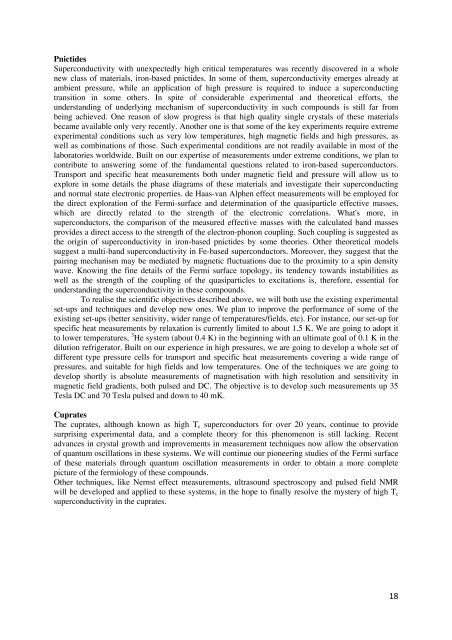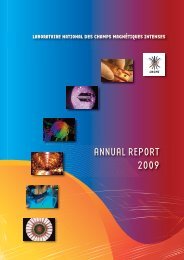Laboratoire National des Champs Magnétiques Pulsés CNRS – INSA
Laboratoire National des Champs Magnétiques Pulsés CNRS – INSA
Laboratoire National des Champs Magnétiques Pulsés CNRS – INSA
Create successful ePaper yourself
Turn your PDF publications into a flip-book with our unique Google optimized e-Paper software.
Pnicti<strong>des</strong><br />
Superconductivity with unexpectedly high critical temperatures was recently discovered in a whole<br />
new class of materials, iron-based pnicti<strong>des</strong>. In some of them, superconductivity emerges already at<br />
ambient pressure, while an application of high pressure is required to induce a superconducting<br />
transition in some others. In spite of considerable experimental and theoretical efforts, the<br />
understanding of underlying mechanism of superconductivity in such compounds is still far from<br />
being achieved. One reason of slow progress is that high quality single crystals of these materials<br />
became available only very recently. Another one is that some of the key experiments require extreme<br />
experimental conditions such as very low temperatures, high magnetic fields and high pressures, as<br />
well as combinations of those. Such experimental conditions are not readily available in most of the<br />
laboratories worldwide. Built on our expertise of measurements under extreme conditions, we plan to<br />
contribute to answering some of the fundamental questions related to iron-based superconductors.<br />
Transport and specific heat measurements both under magnetic field and pressure will allow us to<br />
explore in some details the phase diagrams of these materials and investigate their superconducting<br />
and normal state electronic properties. de Haas-van Alphen effect measurements will be employed for<br />
the direct exploration of the Fermi-surface and determination of the quasiparticle effective masses,<br />
which are directly related to the strength of the electronic correlations. What's more, in<br />
superconductors, the comparison of the measured effective masses with the calculated band masses<br />
provi<strong>des</strong> a direct access to the strength of the electron-phonon coupling. Such coupling is suggested as<br />
the origin of superconductivity in iron-based pnicti<strong>des</strong> by some theories. Other theoretical models<br />
suggest a multi-band superconductivity in Fe-based superconductors. Moreover, they suggest that the<br />
pairing mechanism may be mediated by magnetic fluctuations due to the proximity to a spin density<br />
wave. Knowing the fine details of the Fermi surface topology, its tendency towards instabilities as<br />
well as the strength of the coupling of the quasiparticles to excitations is, therefore, essential for<br />
understanding the superconductivity in these compounds.<br />
To realise the scientific objectives <strong>des</strong>cribed above, we will both use the existing experimental<br />
set-ups and techniques and develop new ones. We plan to improve the performance of some of the<br />
existing set-ups (better sensitivity, wider range of temperatures/fields, etc). For instance, our set-up for<br />
specific heat measurements by relaxation is currently limited to about 1.5 K. We are going to adopt it<br />
to lower temperatures, 3 He system (about 0.4 K) in the beginning with an ultimate goal of 0.1 K in the<br />
dilution refrigerator. Built on our experience in high pressures, we are going to develop a whole set of<br />
different type pressure cells for transport and specific heat measurements covering a wide range of<br />
pressures, and suitable for high fields and low temperatures. One of the techniques we are going to<br />
develop shortly is absolute measurements of magnetisation with high resolution and sensitivity in<br />
magnetic field gradients, both pulsed and DC. The objective is to develop such measurements up 35<br />
Tesla DC and 70 Tesla pulsed and down to 40 mK.<br />
Cuprates<br />
The cuprates, although known as high Tc superconductors for over 20 years, continue to provide<br />
surprising experimental data, and a complete theory for this phenomenon is still lacking. Recent<br />
advances in crystal growth and improvements in measurement techniques now allow the observation<br />
of quantum oscillations in these systems. We will continue our pioneering studies of the Fermi surface<br />
of these materials through quantum oscillation measurements in order to obtain a more complete<br />
picture of the fermiology of these compounds.<br />
Other techniques, like Nernst effect measurements, ultrasound spectroscopy and pulsed field NMR<br />
will be developed and applied to these systems, in the hope to finally resolve the mystery of high Tc<br />
superconductivity in the cuprates.<br />
18







